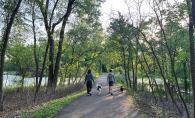Whether you love outdoor entertaining or simply crave a tranquil garden space to unwind after a long day, creating a lovely landscape requires planning. Colleen Moran, landscape designer with Southview Design (2014 Best of Edina winner for best landscaper) offers some important tips for transforming your landscape into your own personal oasis.
First, consider how you want to use your space. Do you need a bigger patio for entertaining? Or do you desire a blooming backyard hideaway all your own? Then, identify problems or opportunities such as steep slopes, overgrown jungle areas or obscured views. Among other things, Moran likes to know a homeowner’s preferred style or color schemes. Do you lean more toward an old-world elegance or are your tastes more geared toward the modern aesthetic? Share these thoughts with an experienced landscape designer and be candid about the extent of maintenance you’re up for and about your budget.
While some landscape projects take a week or less, major overhauls can take up to several weeks to complete. Once a project begins, be available to answer questions from your design firm. “Moving an element a couple of feet so it’s more visible from the kitchen window is easier before it’s fully installed,” says Moran.
When considering plant selections, it’s important to account for soil, light and water requirements for each plant. “Most plants sold in local nurseries are hardy in our zone four growing area,” Moran says. “There are some zone five plants available, but they will require more care and probably a micro-climate to thrive. So remember, choosing the right plant for the right area equals lower maintenance.”
Fast growing trees can satisfy the desire for instant gratification. But some fast growing trees, like willow or aspen, have weaker wood and can require more frequent cleanup of branches. Some growers have begun offering newer tree selections that combine a faster growth rate with strong branching structures. “One example is the Sienna Glen Maple,” says Moran. “However, it is very important to include a variety of tree species in your yard so if one is ever affected by disease or insect, not all of your trees will disappear.”
Any incorporated hardscapes should be functional as well as beautiful. A more casual patio area with large joint spaces filled with loose gravel can add to your maintenance time. If you prefer lower maintenance, consider a patio constructed with smaller joints filled with interlocking polymeric sand. Hardscapes are meant to be walkable; when choosing materials, pay attention to any slip or skid hazards.
Landscape planning for smaller yards requires thinking in terms of inches instead of feet. “In a small lot, every inch is valuable and should be used accordingly,” says Moran. But no matter what size or type of property you own, it’s important to avoid planting one of everything with no cohesion. Your outdoor space should be usable and flow from one area to the next. Material selection and colors should coordinate. The style and scale of plantings and structural elements should correspond with the lot and the home. By integrating all of these components, you’ll achieve a unified design to enjoy for years to come.
Popular outdoor elements to consider:
- Outdoor rooms that include patio, deck, pergolas and kitchens–everything you need to spend hours outdoors with friends and family.
- Fire and water elements like outdoor fireplaces, fire bowls, fire pits, pizza ovens, basalt water fountains and bowls, pondless waterfalls and features, and ornamental splash pools.
- Sustainable landscapes with native plantings, rain gardens, permeable pavers and composting.
- Low voltage lighting.
- Outdoor stereo and television systems built to withstand Minnesota winters.









